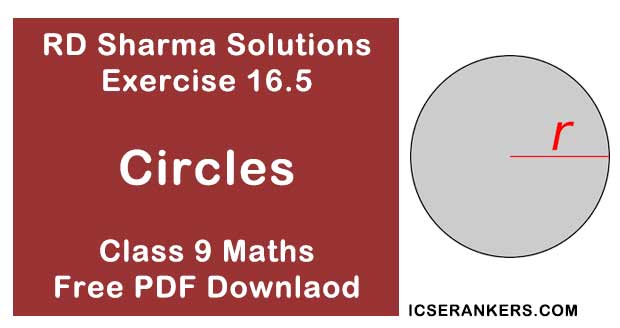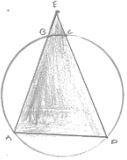Chapter 16 Circles RD Sharma Solutions Exercise 16.5 Class 9 Maths
Chapter Name | RD Sharma Chapter 16 Circles Exercise 16.5 |
Book Name | RD Sharma Mathematics for Class 10 |
Other Exercises | - Exercise 16.1
- Exercise 16.2
- Exercise 16.3
- Exercise 16.4
|
Related Study | NCERT Solutions for Class 10 Maths |
Exercise 16.5 Solutions
1. In the below fig. ΔABC is an equilateral triangle. Find in ∠BEC.

Solution
Since, ΔABC is an equilateral triangles
Then, ∠BAC = 60°
∴ ∠BAC + ∠BEC = 180° [Opposite angles of a quadrilaterals]
⇒ 60° + ∠BEC = 180°
⇒ ∠BEC = 180° - 60°
⇒ ∠BEC = 180°
2. In the below fig. ΔPQR is an isosceles triangle with PQ = PR and m ∠PQR = 35° . Find m ∠QSR and m ∠QTR.

Solution
3. In the below fig., O is the centre of the circle. If ∠BOD = 160°, find the values of x and y. 
Solution
Given that O is the centre of the circle
We have, ∠BOD = 160°
By degree measure theorem
∠BOD = 2∠BCD
⇒ 160° = 2 × x
⇒ x = 160/2 = 80°
∴ ∠BAD + ∠BCD = 180° [Opposite angles of cyclic quadrilaterals]
⇒ y + x = 180°
⇒ y + 80° = 180°
⇒ y = 180° - 80° = 100°
4. In the below fig. ABCD is a cyclic quadrilateral. It ∠BCD = 100° and ∠ABD = 70°, find ∠ADB.

Solution
5. If ABCD is a cyclic quadrilateral in which AD || BC (Fig. below). Prove that ∠B = ∠C.
Solution
Since ABCD is a cyclic quadrilateral with AD || BC.
Then ∠A + ∠C = 180° ... (1) [Opposite angles of cyclic quadrilaterals]
And, ∠A + ∠B = 180° ...(2) [Co interior angles]
Compare (1) and (2) equations ∠B = ∠C
6. In the below fig. O is the centre of the circle. Find ∠CBD.
Solution
Given that ∠BOC = 100°
By degree measure theorem
7. In the below fig. AB and CD are diameters of a circle with centre O. if ∠OBD = 50°, find ∠AOC.

Solution
Given that,
∠OBD = 50°
Since, AB and CD are the diameter of circle then O is the center of the circle
8. On a semi - circle with AB as diameter, a point C is a taken, so that m (∠CAB) = 30°. Find m (∠ACB) and m(∠ABC).
Solution
9. In a cyclic quadrilateral ABCD if AB || CD and ∠B = 70°, find the remaining angles.
Solution
Given that ∠B = 70° = 70°
Since ABCD is a cyclic quadrilaterals
10. In a quadrilateral ABCD, if m ∠A = 3 (m ∠C). Find m ∠A.
Solution
11. In the below fig. O is the centre of the circle and ∠DAB = 50°. Calculate the values of x and y.
Solution
We have ∠DAB = 50°
By degree measure theorem
∠BOD = 2∠BAD
⇒ x = 2 × 50 = 100°
Since, ABCD is a cyclic quadrilateral
Then ∠A + ∠C = 180 °
⇒ 50 + y = 180°
⇒ y = 180° - 50° = 130°
12. In the below fig. in ∠BAC = 60° and ∠BCA = 20° , find ∠ADC.
Solution
By using angle sum property in ΔABC
∠B = 180° - (60° + 20°) = 100°
In cyclic quadrilaterals ABCD, we have :
∠B + ∠D = 180°
∠D = 180° - 100° = 80°
13. In the below fig. if ABC is an equilateral triangle. Find ∠BDC and ∠BEC.
Solution
Since ΔABC is an equilateral triangle
Then, ∠BAC = 60°
∴ ∠BDC = ∠BAC = 60° [Angles in same segment]
Since, quadrilaterals ABEC is a cyclic quadrilaterals
Then ∠BAC + ∠BEC = 180°
⇒ 60° + ∠BEC = 180°
⇒ ∠BEC = 180° - 60° = 120°
14. In the below fig. O is the centre of the circle, if ∠CEA = 30°, find the values of x, y and z. Solution
We have ∠AEC = 30°
Since, quadrilateral ABCE is a cyclic quadrilaterals
Then, ∠ABC + ∠AEC = 180°
x + 30° = 180°
⇒ x = 180 - 30 = 150°
By degree measure theorem
∠AOC = 2∠AEC
⇒ y = 2× 30° = 60°
⇒ ∴ ∠ADC = ∠AEC [Angles in same segment]
15. In the below fig. ∠BAD = 78° , ∠DCF = x° and ∠DEF = y° . Find the values of x, and y.
Solution
We have, ∠BAD = 78°, ∠DCF = x° and ∠DEF = y°
Since, ABCD is a cyclic quadrilateral
Then, ∠BAD + ∠BCD = 180°
⇒ 78° + ∠BCD = 180°
⇒ ∠BCD = 180° - 78° = 102°
Now, ∠BCD + ∠DCF = 180° [Linear pair of angles]
⇒ 102° = x - 180°
⇒ x = 180° - 102° = 78°
Since, DCEF is a cyclic quadrilateral
Then, x + y = 180°
⇒ 78° + y = 180°
⇒ y = 180° - 78° = 102°
∴ y = 102°
16. In a cyclic quadrilateral ABCD, if ∠A - ∠C = 60° , prove that the smaller of two is 60° .
Solution
17. In the below fig. ABCD is a cyclic quadrilateral. Find the value of x.
Solution
18. ABCD is a quadrilateral in which :
(i) BC || AD, ∠ADC = 110° and ∠BAC = 50° . Find ∠DAC.
(ii) ∠DBC = 80° and ∠BAC = 40°, find ∠BCD.
(iii) ∠BCD = 100° and ∠ABD = 70°, find ∠ADB.
Solution
(i)
Since, ABCD is a cyclic quadrilateral
Then, ∠ABC + 110° = 180°
⇒ ∠ABC + 110° = 180°
⇒ ∠ABC = 180° - 110° = 70°
Since AD || BC
Then, ∠DAB + ∠ABC = 180°
[Co - interior angle]⇒ ∠DAC + 50° + 70° = 180°
⇒ ∠DAC = 180° - 120° = 60°
(ii) ∠BAC = ∠BDC = 40° [Angle in same segment]
In ΔBDC, by angle sum property
∠DBC + ∠BCD + ∠BDC = 180°
⇒ 80° + ∠BCD + 40° = 180°
⇒ ∠BCD = 180° - 40° - 80°
⇒ ∠BCD = 60°
(iii) Given that ABCD is a cyclic quadrilaterals
Ten ∠BAD + ∠BCD = 180°
⇒∠BAD + 100° = 180°
⇒ ∠BAD = 180° - 100°
⇒ ∠BAD = 80°
In ΔABD, by angle sum property
∠ABD + ∠ADB + ∠BAD = 180°
⇒ 70° + ∠ADB + 80° = 180°
⇒ ∠ADB = 180° - 150°
⇒ ∠ADB = 30°
19. Prove that the perpendicular bisectors of the sides of a cyclic quadrilateral are concurrent.
Solution
Let ABCD be a cyclic quadrilateral, and let O be the center of the corresponding circle.
Then, each side of the equilateral ABCD is a chord of the circle and the perpendicular
bisector of a chord always passes through the center of the circle.
So, right bisectors of the sides of quadrilaterals ABCD, will pass through the circle O of the
corresponding circle
20. Prove that the centre of the circle circumscribing the cyclic rectangle ABCD is the point of intersection of its diagonals.
Solution
Let O be the circle circumscribing the cycle rectangle ABCD. Since ∠ABC = 90° and AC is a chord of the circle, so AC is a diameter of a circle. Similarly BD is a diameter
Hence, point of intersection of AC and BD is the center of the circle
21. Prove that the circles described on the four sides of a rhombus as diameters, pass through the point of intersection of its diagonals.
Solution
Let ABCD be a rhombus such that its diagonals AC and BD interest at O
Since, the diagonals of a rhombus intersect at right angle
∴ ∠ACB = ∠BOC = ∠COD = ∠DOA = 90°
Now, ∠AOB = 90°
⇒ circle described on BC, AD and CD as diameter pass through O.
22. If the two sides of a pair of opposite sides of a cyclic quadrilateral are equal, prove that its diagonals are equal.
Solution

Given ABCD is a cyclic quadrilateral in which AB = DC
To prove : AC = BD
Proof : In ΔPAB and ΔPDC
Given that AB = DC
∠BAD = ∠CDP [Angles in the same segment]
∠PBA = ∠PCD [Angles in same segment]
Then ΔPAB = ΔPDC ...(1) [c.p.c.t]
PC = PB ...(2) [c.p.c.t]
Add equation (1) and (2)
PA + PC = PD + PB
⇒ AC = BD
23. ABCD is a cyclic quadrilateral in which BA and CD when produced meet in E and EA = ED. Prove that
(i) AD || BC
(ii) EB = EC
Solution
Given ABCD is a cyclic quadrilateral in which EA = ED
To prove:
(i) AD || BC
(ii) EB = EC
Proof:
(i) Since EA = ED
Then ∠EAD = ∠EDA [Opposite angles to equal sides]
Since, ABCD is a cyclic quadrilaterals
Then, ∠ABC + ∠ADC = 180°
But ∠ABC + ∠EBC = 180° [Linear pair of angles]
Then ∠ADC = ∠EBC ...(2)
Compare equation (1) and (2)
∠EAD = ∠CBA ...(3)
Since, corresponding angle are equal
Then BC || AD
(ii) From equation (2)
∠EAD = ∠CBA ...(3)
Since, corresponding angle are equal
Then BC || AD
(ii) From equation (2)
∠EAD = ∠EBC ...(3)
Similarly ∠EDA = ∠ECB ...(4)
Compare equation (1), (3) and (4) ∠EBC = ∠ECD
⇒ EB = EC (Opposite angles to equal sides)
24. Circles are described on the sides of a triangle as diameters. Prove that the circles on any
two sides intersect each other on the third side (or third side produced).
Solution
Since AB is a diameter
Then ∠ADB = 90° ...(1) [Angle in semicircle]
Since AC is a diameter
Then ∠ADC = 90° ...(2) [Angle in semicircle]
Add equation (1) and (2)
∠ADB + ∠ADC = 90° + 90°
⇒ ∠BDC = 180°
Then, BDC is a line
Hence, the circles on any two sides intersect each other on the third side
25. Prove that the angle in a segment shorter than a semicircle is greater than a right angle.
Solution
27. ABCD is a cyclic trapezium with AD || BC. If ∠B = 70° , determine other three angles of the trapezium.
Solution

Given that
ABCD is a cyclic trapezium with AD || BC and ∠B = 70°
Since, ABCD is a quadrilateral
Then ∠B + ∠D = 180°

28. Prove that the line segment joining the mid - point of the hypotenuse of a right triangle to its opposite vertex is half of the hypotenuse.
Solution
Let ΔABC be a right angle triangle at angle B.
Let P be the midpoint of hypotenuse AC.
Draw a circle with center P and AC as a diameter
Since, ∠ABC = 90° , therefore the circle passes through B
∴ BP = radius
Also AD = CP = Radius
∴ AP = BP = CP
Hence, BP = 1/2 AC.
29. In Fig. below, ABCD is a cyclic quadrilateral in which AC and BD are its diagonals. If ∠DBC = 55° and ∠BAC = 45°, find ∠BCD .
Solution
Since angles in the same segment of a circle are equal
∴ ∠CAD = ∠DBC = 65°
∴ ∠DAB = ∠CAD + ∠BAC = 55° + 45° = 100°
But, ∠DAB + ∠BCD = 180° [Opposite angles of a cyclic]
∴ ∠BCD = 180° - 100° = 80°
∴ ∠BCD = 80°


































